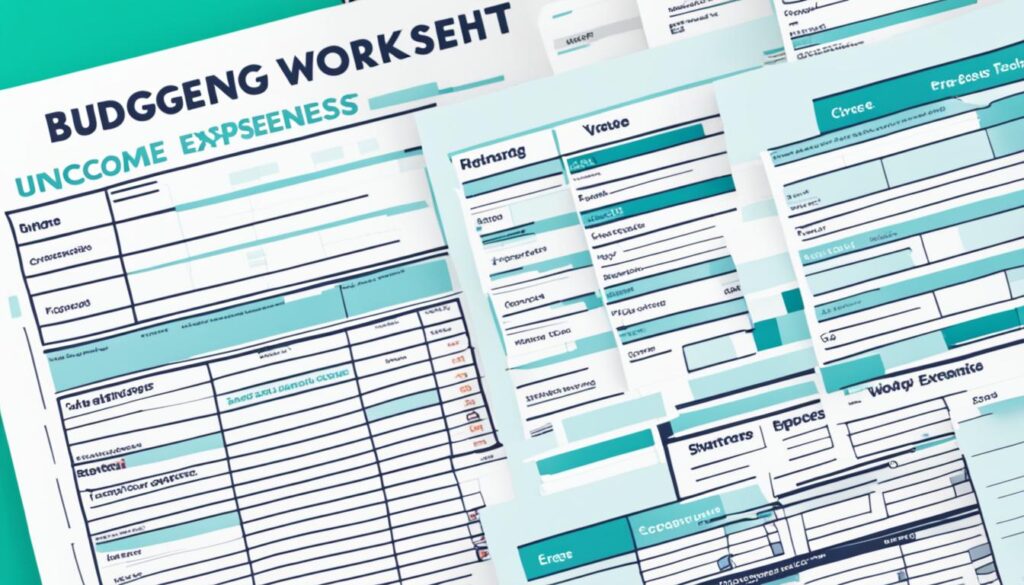Studies show that individuals who follow a budget are more likely to pay off debt, save money, and achieve their financial goals. Yet, many people find the idea of budgeting overwhelming or confusing.
Click here to purchase a Financial Planner on Amazon
That’s where I come in. In this article, I’ll share my 10-step guide to creating a simple budget that anyone can follow. Whether you’re a budgeting novice or looking for new tips and strategies, this easy budgeting guide is designed for beginners like you.
Key Takeaways:
- Creating a budget is essential for achieving financial stability and reaching your goals.
- Follow these 10 steps to simplify the budgeting process and take control of your finances.
- Learn how to track your spending, categorize expenses, and make adjustments as needed.
- Automate savings and use technology to make budgeting easier and more convenient.
- Regularly review your budget and reflect on your progress to stay on track.
Step 1: Do your homework
Before diving into budgeting, it’s important to educate yourself about personal finance and financial planning. By doing your homework and learning about money management techniques, you’ll be better equipped to create a budget that works for you.
Financial planning is a crucial aspect of budgeting, as it helps you set goals and make informed decisions about your money. Whether you’re a budgeting beginner or looking to refine your existing budgeting strategy, taking the time to learn the ins and outs of financial planning will pay off in the long run.
By familiarizing yourself with budgeting principles and techniques, you’ll gain the confidence to take control of your finances and make smarter financial choices. Consider reading books, attending workshops or webinars, or consulting with a financial advisor to expand your knowledge and skills.
Step 2: Know what you earn and what you spend
Determining your total income and tracking your expenses is a crucial step in understanding your financial situation. By identifying all sources of income and listing your monthly expenses, you’ll gain a clear picture of where your money is coming from and where it’s going. This knowledge forms the foundation of effective budgeting and money management.
Understanding your income is the first part of this step. Take into account all the money that flows into your bank account each month, including your salary, bonuses, rental income, and any other sources of revenue. Make sure to have an accurate record of your income to accurately plan your budget.
The second part of this step involves tracking your expenses. Create a budgeting worksheet or use budgeting apps to record all your expenses. Keep track of every dollar you spend, whether it’s on utilities, groceries, transportation, entertainment, or any other category. This level of detail will help you identify areas where you can cut back and save money.
Having a clear understanding of your income and expenses will allow you to make informed decisions about your financial priorities. You’ll be able to identify areas where you can reduce spending and increase savings. This step sets the stage for creating a budget that aligns with your financial goals.
“I didn’t realize how much money I was spending on dining out until I started tracking my expenses. It was an eye-opening experience that helped me make positive changes in my money management habits.” – Sarah Thompson
Studies show that individuals who follow a budget are more likely to pay off debt, save money, and achieve their financial goals. Yet, many people find the idea of budgeting overwhelming or confusing.
Click here to purchase a Financial Planner on Amazon
Income and Expenses Summary:
| Income | Expenses |
|---|---|
| Salary: $4,000 | Rent: -$1,200 |
| Bonus: $500 | Utilities: -$150 |
| Rental Income: $700 | Groceries: -$300 |
| Transportation: -$200 | |
| Total Income: $5,200 | Entertainment: -$100 |
Knowing what you earn and what you spend is the essential starting point for effective budgeting and money management. It provides you with the necessary information to make informed financial decisions and set realistic goals. By gaining clarity on your income and expenses, you can take control of your finances and work towards financial stability and success.

Step 3: Track your spending
Tracking your spending is a crucial component of effective money management and budgeting strategies.
By keeping a record of your expenses, you gain valuable insight into your spending habits and patterns. This awareness allows you to make informed decisions about where you can cut back and save money.
There are various ways to track your spending:
- Utilize a spending tracker app: There are numerous mobile apps available that can help you monitor your expenses conveniently. These apps categorize your expenses automatically, making it easier to analyze your spending habits.
- Keep receipts: Holding onto physical receipts or using digital receipts can provide a tangible record of your expenses. You can sort and categorize these receipts to get a comprehensive overview of your spending.
- Use budgeting spreadsheets: Creating and maintaining a budgeting spreadsheet can be an effective method for tracking your spending. This manual approach allows you to customize the tracking process to suit your needs.
By consistently and accurately tracking your spending, you can identify areas where you may be overspending and implement necessary changes to align with your budgeting goals.
Remember, tracking your spending is an ongoing practice that requires discipline and commitment. It is a vital step in gaining control over your finances and achieving long-term financial stability.
Now, let’s take a look at an example of how tracking your spending can help you make informed budgeting decisions:
| Expense Category | Amount Spent (Monthly) |
|---|---|
| Groceries | $400 |
| Eating Out | $250 |
| Entertainment | $150 |
| Utilities | $200 |
| Transportation | $150 |
Looking at the table above, you may notice that your spending on eating out is relatively high compared to other categories. This insight may prompt you to make adjustments, such as cooking more meals at home or reducing the frequency of dining out. By reallocating some of the funds from eating out to other essential categories, such as groceries or utilities, you can achieve a better balance within your budget.
Step 4: Categorize your spending
When it comes to effective budgeting strategies and money management, one essential step is to categorize your spending. By organizing your expenses into different categories, you gain a clearer understanding of where your money is going and can make more informed decisions to stay within your budget.
Creating categories allows you to prioritize your expenses based on their importance and identify areas where adjustments can be made. This level of insight helps you allocate your resources wisely and maximize your financial well-being.
Here are some tips on how to categorize your spending effectively:
- Start with broad categories: Begin by creating broad categories that capture the major areas of your spending, such as housing, transportation, groceries, utilities, and entertainment.
- Refine the categories: Once you have your broad categories, further refine them into more specific subcategories. For example, under the “transportation” category, you could have subcategories like fuel, maintenance, and public transportation.
- Be consistent: Use the same categories and subcategories consistently across your budgeting tools and systems. This helps maintain clarity and continuity in your budgeting process.
- Adapt to your lifestyle: Customize the categories to fit your unique lifestyle and spending patterns. Tailor them to match your priorities and financial goals.
- Review and update regularly: Regularly review your categories and make adjustments as necessary. As your financial circumstances change or your spending habits evolve, your categories may need to be revised to accurately reflect your current situation.
By categorizing your spending, you’ll gain valuable insights into your financial habits and be better equipped to make informed decisions about your money. It’s an effective strategy for maintaining control over your finances and ensuring you’re on the right track towards your financial goals.
Pro Tip: Tracking your spending
“Tracking your spending goes hand in hand with categorizing your expenses. By diligently recording your transactions and keeping track of where your money goes, you can identify trends, pinpoint areas for improvement, and make adjustments to align with your budgeting goals.”
Remember, the key to successful budgeting and money management lies in understanding your spending patterns. So take the time to categorize your expenses and gain valuable insights into your financial habits.
Step 5: List your goals
When it comes to financial planning and budgeting strategies, goal-setting is a critical step. By clearly defining your aspirations, you can align your budget with your dreams and aspirations. Whether you’re focused on short-term objectives like building an emergency fund or long-term goals such as saving for retirement or purchasing your dream home, having a list of specific, measurable, achievable, relevant, and time-bound (SMART) goals can keep you motivated and focused on your financial journey.
Consider creating a financial goals list that encompasses both immediate and future desires. Start with short-term goals like paying off debt or saving for a vacation. Then, move on to long-term goals such as saving for college education or establishing a retirement fund. Remember, these goals should be tailored to your unique circumstances and priorities.
Listing your goals in your budget can serve as a constant reminder of what you’re working towards, helping you make informed decisions about your spending and savings. By keeping your aspirations front and center, you’ll be more motivated to stick to your budget and make the necessary adjustments to achieve your desired financial outcomes.
“Setting financial goals allows you to prioritize your spending and align it with your values and aspirations.”
Here’s an example of how you can format your financial goals list within your budget:
| Financial Goals | Amount to Save | Target Date |
|---|---|---|
| Emergency Fund | $5,000 | December 2023 |
| Home Down Payment | $50,000 | December 2026 |
| Retirement Savings | $1,000,000 | December 2040 |

Remember, financial planning goes beyond just creating a budget. It’s about setting goals and making intentional decisions to achieve a more secure financial future. With your goals listed and visible, you’ll be equipped to make informed decisions about your spending and saving, helping you stay on track and on target.
Step 6: Decide where to cut back
When it comes to budgeting strategies and effective money management, one of the key steps is to analyze your expenses and identify areas where you can cut back. By doing so, you can free up more money to allocate towards your financial goals. Whether you’re saving for a vacation, paying off debt, or building an emergency fund, every small saving can add up over time.
“A penny saved is a penny earned.” – Benjamin Franklin
To start cutting back, take a closer look at your monthly spending. Identify any areas where you may be overspending or where you can find more cost-effective alternatives. Here are a few budgeting strategies to consider:
1. Reduce discretionary spending
Consider cutting back on non-essential expenses such as eating out, entertainment, or shopping. Look for ways to enjoy free or low-cost activities and find creative alternatives that won’t strain your budget.
2. Renegotiate bills
Contact your service providers, such as cable or internet companies, to negotiate lower rates. Sometimes, just a simple phone call can lead to significant cost savings.
3. Find more affordable alternatives
Shop around for better deals on your regular expenses. Compare prices, switch to generic brands, or explore online options that offer lower prices. Remember, even small savings can make a big difference in the long run.
By implementing these budgeting strategies, you can identify areas of potential savings and make adjustments to your spending habits. This proactive approach not only helps you stay within your budget but also empowers you to take control of your financial future.
Step 7: Create your budget
When it comes to effective financial planning, creating a budget is a crucial step. To help you stay organized and in control of your finances, utilize a budgeting tool such as a spreadsheet or a dedicated budgeting app. These tools will enable you to create a comprehensive budget tailored to your individual needs and financial goals.
Start by listing your income sources, including your salary, freelance earnings, or any other sources of revenue. Next, categorize your expenses into fixed and variable expenses. Fixed expenses include items such as rent or mortgage payments, utility bills, and insurance premiums. Variable expenses, on the other hand, are more flexible and can include things like groceries, entertainment, or dining out.
Allocate specific amounts for each category based on your income and spending habits. This step will help you gain a clear understanding of how much money you have available for each expense category and ensure that your total expenses do not exceed your income.
Creating a budget allows you to prioritize your financial goals and make informed decisions about your spending. It empowers you with a clear roadmap for managing your money and making adjustments as needed to stay on track.
Remember, consistency is key. Regularly review and update your budget to reflect any changes in your income or expenses. By staying committed to your budgeting plan and effectively managing your finances, you’ll be well on your way to achieving your financial goals.
Click line to purchase Financial Planner on Amazon:
Benefits of Using a Budgeting Worksheet
Using a budgeting worksheet can greatly simplify the budgeting process. It provides a structured format for organizing your finances and helps ensure that no expense or income source goes overlooked. Here are some key benefits of using a budgeting worksheet:
- Clarity: A budgeting worksheet allows you to have a clear overview of your financial situation, making it easier to identify areas where you can make adjustments and improve your financial health.
- Organization: By categorizing your income and expenses in a budgeting worksheet, you can easily track and manage your money. It helps you keep an organized record of your financial transactions.
- Financial Awareness: Using a budgeting worksheet promotes financial awareness. It encourages you to carefully consider your spending habits and make conscious decisions about where your money goes.
By utilizing a budgeting worksheet in conjunction with a budgeting tool, you can create a solid foundation for successful financial planning and ensure that you are making the most of your financial resources.
| Income | Fixed Expenses | Variable Expenses |
|---|---|---|
| Salary | Rent/Mortgage | Groceries |
| Freelance Earnings | Utilities | Entertainment |
| Other Sources | Insurance Premiums | Dining Out |
Step 8: Make it easy
Simplifying your budgeting process is key to successful money management. By leveraging technology and implementing a few smart strategies, you can make budgeting a breeze and increase your chances of staying on track. Here are some budgeting tips to help you streamline your financial management:
- Automate Savings: Set up automatic transfers from your checking account to a separate savings or investment account. This will help you consistently save money without having to manually transfer it each month.
- Embrace Technology: Use mobile banking apps or budgeting tools to track your spending and manage your finances on the go. These apps can provide real-time insights into your expenses and help you identify areas where you may be overspending.
- Set Bill Payment Reminders: Avoid late fees and missed payments by setting up reminders for your recurring bills. Take advantage of calendar notifications, email alerts, or reminders within budgeting apps to ensure you stay on top of your financial obligations.
“By leveraging technology and implementing a few smart strategies, you can make budgeting a breeze and increase your chances of staying on track.”
By simplifying the budgeting process, you remove barriers that may prevent you from managing your money effectively. Automating savings and utilizing technology allow you to stay organized, monitor your spending habits, and make informed financial decisions. Take advantage of these budgeting tips to make money management a stress-free experience.
Budgeting Made Easy
Implementing automation and utilizing technology can transform how you approach budgeting. By adopting these budgeting tips, you’ll be well-equipped to manage your finances effectively and achieve your financial goals with ease.
Step 9: Reflect
Regularly reviewing your budget and spending is crucial to ensure you’re staying on track with your financial goals. Reflection is an essential step in maintaining control over your finances and ensuring that your budget continues to meet your needs.
Take the time to reflect on your progress and evaluate whether you are on target or need to make adjustments. By analyzing your budgeting strategies and money management techniques, you can identify areas for improvement and make informed decisions.
During your reflection, consider the following:
- Are you achieving your financial goals? Evaluate whether your budgeting strategies are helping you make progress towards your goals. If necessary, adjust your budget and spending habits to align better with your objectives.
- Are there any unexpected expenses? Life is full of surprises, and it’s important to assess how unexpected expenses may impact your budget. Reflect on how you can prepare for unforeseen circumstances by including a contingency fund or adjusting your savings plans.
- What budgeting strategies have been most effective? Identify the budgeting strategies that have worked well for you. Whether it’s tracking your spending, categorizing expenses, or automating savings, pay attention to what has contributed to your financial success.
- What adjustments can you make? Consider where you can fine-tune your budget and money management techniques. Reflect on your spending patterns and identify areas where you can cut back or reallocate funds to achieve a healthier financial position.
Taking the time to reflect and make necessary adjustments will help you maintain control over your finances and stay on the path towards financial success. Remember, budgeting is an ongoing process, and regular reflection is key to keeping your budget relevant and effective.
Conclusion
Creating a simple budget is a crucial step towards financial stability and achieving your goals. By following these 10 steps, you can take control of your finances, improve your money management skills, and make meaningful progress towards a more secure financial future.
Remember, budgeting is an ongoing process that requires regular maintenance and adjustments. It’s not a one-time task, but rather a lifelong habit that can help you stay on top of your finances.
Stick to your budget and stay committed to your financial goals, and you’ll be on your way to financial success. With proper budgeting, even beginners can start building a solid foundation for their financial well-being. Don’t wait any longer – start budgeting today and reap the benefits of effective money management!
FAQ
What is a budget?
A budget is a planning tool that reflects an organization’s programs, mission, and strategic plan. It helps in managing finances effectively.
How many steps are there to create a simple budget?
There are 10 steps to create a simple budget plan, starting from educating yourself about personal finance to regularly reviewing and adjusting your budget.
Why is it important to educate myself about personal finance and budgeting?
Educating yourself about personal finance and budgeting helps you acquire money management techniques and create an effective budget that aligns with your financial goals.
How do I determine my total income and track my expenses?
To determine your total income and track your expenses, identify all sources of income and list all your expenses each month. This gives you a clear picture of your financial situation.
How can I gain insight into my spending habits?
Keeping a record of your expenses through a spending tracker app, receipts, or budgeting spreadsheets helps you gain insight into your spending habits.
Why is it important to organize my expenses into categories?
Organizing expenses into categories allows you to understand where your money is going, prioritize expenses, and identify areas where you can make adjustments to stay within your budget.
Why should I determine my financial goals?
Determining your financial goals, both short-term and long-term, helps you stay motivated, focused, and directed towards your budgeting efforts. It gives you a sense of purpose and guides your financial decisions.
How do I identify areas where I can cut back on expenses?
By analyzing your expenses, you can identify areas where you can cut back and save money. This may involve reducing discretionary spending, renegotiating bills, or finding more affordable alternatives.
What tools can I use to create a comprehensive budget?
You can use budgeting tools such as spreadsheets or budgeting apps to create a comprehensive budget. These tools help in organizing your income, fixed expenses, and variable expenses.
How can I simplify the budgeting process?
You can simplify the budgeting process by automating savings and setting up reminders for bill payments. Utilizing technology, such as mobile banking apps, can also help you track your spending and stay on top of your budget.
Why is it important to regularly review my budget and spending?
Regularly reviewing your budget and spending ensures you stay on track towards your financial goals. It helps you make adjustments as necessary and maintain control over your finances.
Studies show that individuals who follow a budget are more likely to pay off debt, save money, and achieve their financial goals. Yet, many people find the idea of budgeting overwhelming or confusing.


